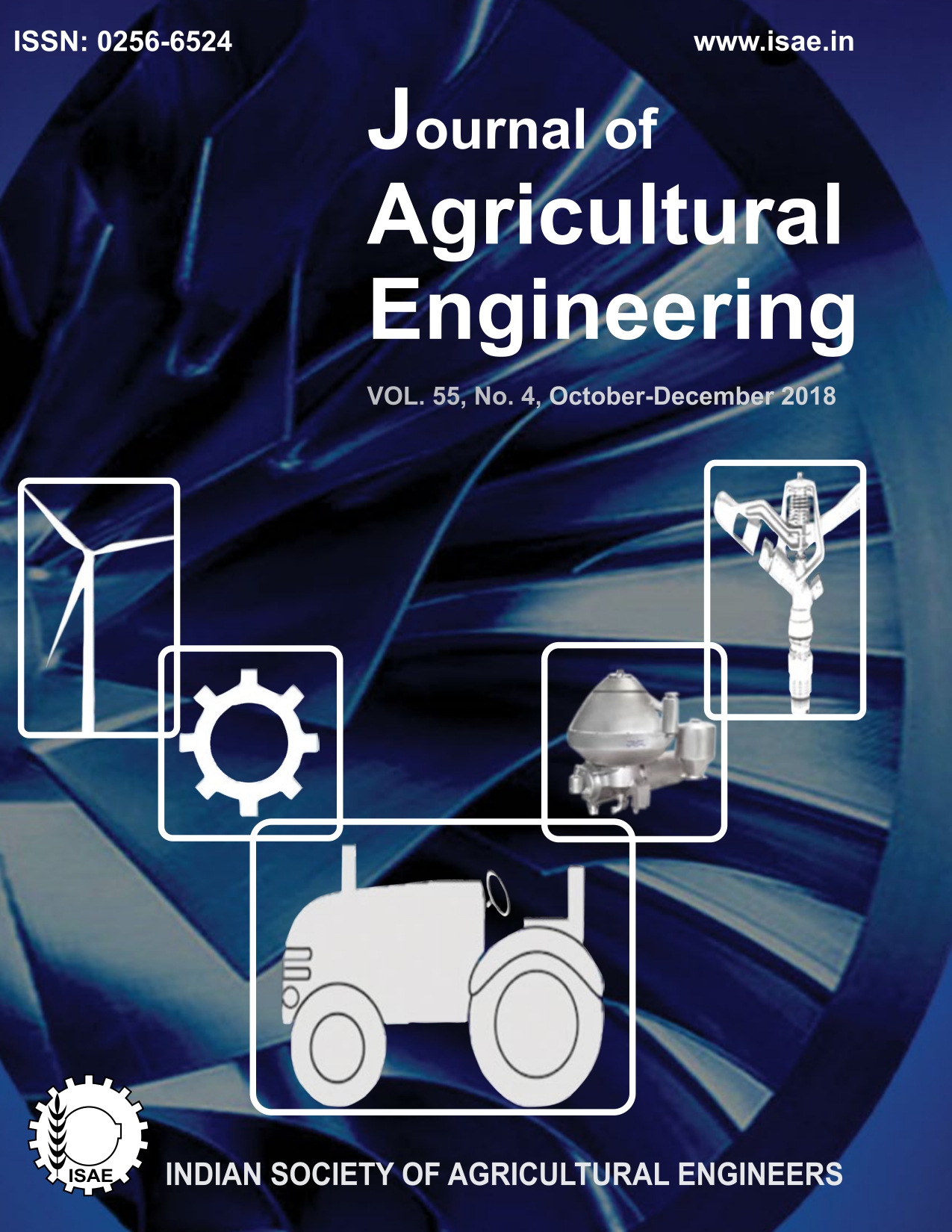Temporal Land-use Change Analysis of Patiala-Ki-Rao Watershed in Shivalik Foot-Hills using Remote Sensing and GIS
DOI:
https://doi.org/10.52151/jae2018554.1669Keywords:
Landsat imagery, land-use change, supervised classification, change detection matrix, Patiala-ki-Rao watershedAbstract
Land-use change due to urbanization is continuously decreasing agricultural and forest lands that has important implications on the sustainable livelihood of the inhabitants of a watershed. In this study, land-use maps of Patiala-Ki-Rao watershed that is located in Shivalik foot-hills in Mohali district, Punjab were generated in GIS environment using Landsat imageries for the years 2006 and 2016 with overall classification accuracy and Kappa statistic of above 90 % and 0.9, respectively. The analysis of land-use maps indicated that the area under all land-uses decreased over a decade, except built-up land that increased by 372.27 ha (112.04 %) mainly due to urbanisation in the watershed. The change detection matrix revealed that out of 906.98 ha under agricultural land in 2006, 197.43 ha were mainly converted to built-up land. Likewise, from forest cover of 3462.21 ha in 2006, 151.11 ha were converted to agricultural land and 75.05 ha to built-up land. These land-use changes, if continued, may cause a serious threat to watershed resources, and hence calls for proper land-use policy formulation.
References
Bazgeer S; Sharma P K; Mahey R K; Hundal S S; Sood A. 2007. Assessment of land-use changes using remote sensing and GIS and their implications on climatic variability for Balachaur watershed in Punjab, India. Desert,12(2), 139-147.
Bhardwaj A; Kaushal M P. 2009. Two dimensional physically based finite element runoff model for small agricultural watershed. Hydrol. Processes, 23(3), 397-407.
Bhardwaj A; Rana D S. 2008. Torrent control measures in Kandi area of Punjab - A case study. J. Water Manage., 16, 55-63.
Biggelaar D C; Lal R; Wiebe K; Breneman V; Reich P. 2004. The global impact of soil erosion on productivity II: effects on crop yields and production overtime. Adv. Agron., 81(1), 49-95.
Butt A; Shabbir R; Ahmad S S; Aziz N. 2015. Land use change mapping and analysis using Remote sensing and GIS: A case study of Simly watershed, Islamabad, Pakistan. Egypt. J. Remote Sens. Space Sci., 18(2), 251-259.
Chilar J. 2000. Land cover mapping of large areas from satellites: status and research priorities. Int. J. Remote Sens., 21(7), 1093–1114.
Jensen J R; Im J. 2007. Remote sensing change detection in urban environments. In: Jensen R R; Gatrell J D and McLean D (Eds.) Geo-spatial Technologies in Urban Environments: Policy, Practice and Pixels, second Ed., 7–30. Springer-Verlag, Heidelberg.
Kachhwala T S. 1985. Temporal monitoring of forest land for change detection and forest cover mapping through satellite remote sensing. In: Proc 6th Asian Conference on Remote Sensing, National Remote Sensing Agency, Hyderabad, 77—83.
Khan R; Jhariya D C. 2018. Assessment of land use and land cover change and its impact on ground water quality using remote sensing and GIS techniques in Raipur city, Chhattisgarh, India. J. Geolog. Soc. India, 92(1), 59-66.
Lafond G P; May W E; Stevenson F C; Derksen D A. 2006. Effects of tillage systems and rotations on crop production for a thin black chernozem in the Canadian Prairies. Soil Till. Res.,89, 232-245.
Lea C; Curtis A C. 2010. Thematic accuracy assessment procedures: National Park Service Vegetation Inventory, version 2.0. Natural Resource Report NPS/2010/ NRR–2010/204, National Park Service, Fort Collins, Colorado, USA.
Lo C P; Choi J. 2004. A hybrid approach to urban land use/cover mapping using LANDSAT7 enhanced thematic mapper plus (ETM+) images. Int. J. Remote Sens., 25(14), 2687-2700.
Lu Q; Weng D. 2005. Urban classification using full spectral information of Landsat ETM+ imagery in Marion County, Indiana. Photogramm. Eng. Remote Sens.,71(11), 1275–1284.
Mei A; Manzo C; Fontinovo G; Bassani C; Allegrini A; Petracchni F. 2016. Assessment of land cover changes in Lampedusa island (Italy) using Landsat TM and QLI data. J. Afr. Earth Sci.,122(1),15-24.
Rahman A; Kumar S; Fazal S; Siddiqui M A. 2012. Assessment of land use/land cover change in the north-west district of Delhi using remote sensing and GIS techniques. J. Ind. Soc. Remote Sens., 40(4), 689-697.
Rawat J S; Kumar M. 2015. Monitoring land use/ cover change using remote sensing and GIS techniques: A case study of Hawalbagh block, district Almora, Uttarakhand, India. Egypt. J. Remote Sens. Space Sci., 18(1), 77-84.
Rosenfield G H; Fitzpatirck-Lins K. 1986. A coefficient of agreement as a measure of thematic classification accuracy. Photogramm. Eng. Remote Sens., 52(2), 223–27.
Singh C; Sharma P K; Verma V K; Chopra R. 1994. Delineation and codification of subwatersheds in Kandi area of Punjab. Atlas, Punjab Remote Sensing Centre, Ludhiana, (35+xx).
Sur H S; Bhardwaj A; Jindal P K. 2001. Performance evaluation and impact assessment of small water harvesting structures in the Shivalik foot-hills of Northern India. Am. J. Alternative Agri., 16(3), 124-130.
Unnikrishnan C K; Gharai B; Mohandas S; Mamgain A; Rajagopal E N; Iyengar G R; Rao P V 2016. Recent changes on land use/land cover over Indian region and its impact on weather prediction using unified model. Atm. Sci. Letters, 17(1), 294-300.
Watson R T; Zakri A H. 2003. Millennium Ecosystem Assessment - Ecosystems and Human Wellbeing, A Framework for Assessment. United Nations Environment Programme and World Resources Institute, Washington DC, pp: 245.
Weng Q. 2001. A remote sensing-GIS evaluation of urban expansion and its impact on surface temperature in the Zhujiang Delta, southern China. Int. J. Remote Sens., 22(10), 1999–2014.
Weng Q. 2002. Land use change analysis in the Zhujiang Delta of China using satellite remote sensing, GIS and stochastic modelling. J. Environ. Manage., 64(3), 273-284.
Yadav R P; Aggarwal R K; Bhattacharyya P; Bansal R C. 2005. Infiltration characteristics of different aspects and topographical locations of hilly watershed in Shivalik lower Himalayan region in India. Ind. J. Soil Conserv., 33(1), 44-48.
Yousuf A; Bhardwaj A; Tiwari A K; Bhatt V K. 2015. Modelling runoff and sediment yield from a small forest watershed in Shivalik foot-hills using WEPP model. Int. J. Agric. Sci. Res., 5(1), 67-78.














